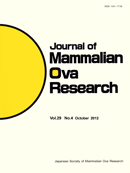Volume 30, Issue 4
Displaying 1-8 of 8 articles from this issue
- |<
- <
- 1
- >
- >|
総説(特集:ICSIの可能性と問題点)
-
2013Volume 30Issue 4 Pages 119
Published: 2013
Released on J-STAGE: December 05, 2013
Download PDF (101K) -
Effect of in vitro Manipulation on Development of Pre-implantation Embryos: Lecture of Light Effects2013Volume 30Issue 4 Pages 120-126
Published: 2013
Released on J-STAGE: December 05, 2013
Download PDF (1036K) -
2013Volume 30Issue 4 Pages 127-134
Published: 2013
Released on J-STAGE: December 05, 2013
Download PDF (665K) -
2013Volume 30Issue 4 Pages 135-144
Published: 2013
Released on J-STAGE: December 05, 2013
Download PDF (1907K) -
2013Volume 30Issue 4 Pages 145-148
Published: 2013
Released on J-STAGE: December 05, 2013
Download PDF (470K) -
2013Volume 30Issue 4 Pages 149-154
Published: 2013
Released on J-STAGE: December 05, 2013
Download PDF (550K) -
2013Volume 30Issue 4 Pages 155-158
Published: 2013
Released on J-STAGE: December 05, 2013
Download PDF (725K) -
2013Volume 30Issue 4 Pages 159-167
Published: 2013
Released on J-STAGE: December 05, 2013
Download PDF (666K)
- |<
- <
- 1
- >
- >|
